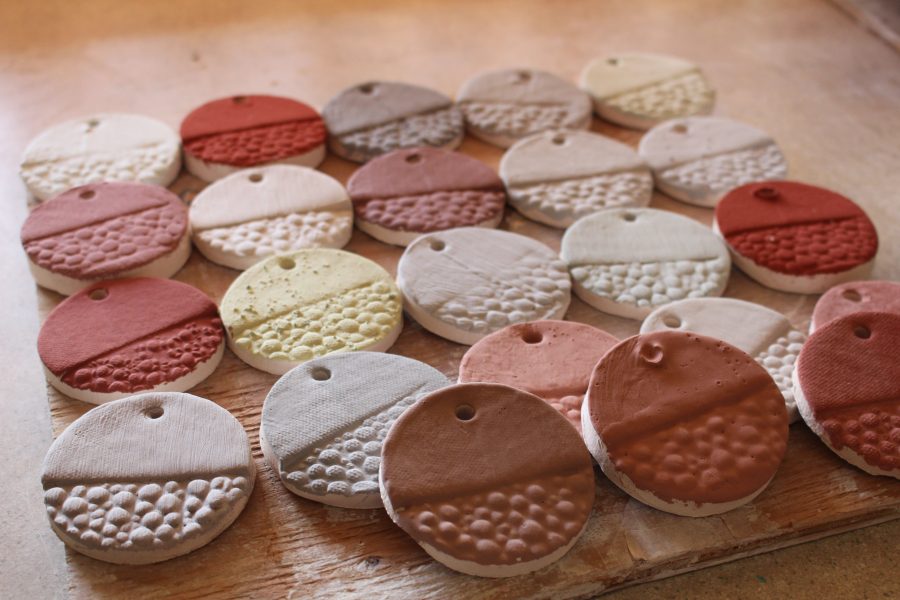Around the year 24,000 B.C., ancient humans discovered the revolutionary combination of clay and kiln. This groundbreaking innovation carved the path for many remarkable creations, such as prehistoric Mesopotamian vases, delicate Japanese porcelain dishware and the indestructible Chinese Terracotta Army.
Although these works of clay art include a wide spectrum of styles and uses, they are most often categorized under a single term: ceramics. Ceramics is a very unique art form in which clay is shaped to construct a multitude of three-dimensional objects, ranging from housewares to artistic masterpieces.
“Ceramics is a very physical discipline and it’s very tactile; your main tools are your hands and you get dirty,” said Steve Ferrera, Palo Alto High School ceramics teacher. “There are a lot of directions you can go with the medium because it exists in many different states — from slip, where it’s like a heavy cream, to bone-dry, where it’s like carving a soft stone.”
Much like how sculptors Michelangelo and Pablo Picasso carefully chiseled their way into history with their magnificent sculptures, numerous Paly students spend countless hours in and out of class perfecting their own clay creations through Paly’s expansive ceramics program. Students enrolled in the program enjoy the abundance of the school’s resources and expand their creativity and skillsets through the completion of a wide range of ceramic assignments.
“The main goal [of the program] is for kids to learn the processes and develop the skill sets that a ceramic artist uses,” Ferrera said. “Students will have enough mastery of the pottery wheel where they can make cups and bowls with a trimmed foot and sculptures that are somewhat complex in construction and concept.”
Steve Ferrera, Palo Alto High School ceramics teacher
The extensive sculpting process takes up to a month to fully complete. Artists begin by using wet clay to shape a rough construction of the final project. Then, they fire it in the kiln, an oven that is heated at around 1,000 degrees Fahrenheit.
After firing their sculptures for the first time, the students wait for the now-firm clay to cool and proceed to glaze, paint and decorate their creations. They then fire the clay in the kiln for a second time; the scorching heat of the oven hardens the glaze, making it look shiny, smooth and ready for display. Students are then free to take their creations home and showcase them for their own enjoyment.
To many, ceramics may seem like an intimidating art form, with its long process and use of high temperatures. However, ceramics attracts numerous students because of its appeal to artists of different skillsets and creative abilities. Virtually anyone with the right mindset is able to partake in this art form.
“You’re basically playing with mud, so it’s fun,” Ferrera said. “But it also involves patience, planning and discipline, so it’s an opportunity to build skills while having fun. There’s a comfort zone for everyone. You can be precise and meticulous or loose and spontaneous.”
According to sophomore Lucy Volino, who is currently enrolled in “Ceramics/Sculpture” at Paly, there are two main projects used to create different types of ceramics: pottery wheel projects and sculpture-based projects.
Pottery wheel projects, in which students are aided by revolving machines to shape their sculptures, produce more practical creations that can be used daily. Ceramic creations constructed using this technique are usually not very intricate, but rather more smooth in texture and simple in shape.
“[In pottery wheel projects], we’re supposed to make things like bowls, cups or things that are pot-shaped on a rotating wheel,” Volino said. “These are often more symmetrical and are more consistent.”
With sculpture-based projects, however, students can be more creative and liberal with the shapes, consistency and complexities of their creations. These types of projects usually generate more detailed designs that are displayed as art forms rather than used as household items.
“Our most recent [sculpture-based] project was an assignment on a bust or a head from a character from a story or a book or a movie that we liked,” Volino said. “I did Tintin.”
Students can specialize in the art of ceramics by enrolling in “Ceramics/Sculpture,” which is a prerequisite for “Advanced Sculpture.” The “Ceramics/Sculpture” class introduces students to the basics of ceramics by helping them ease into the sculpting process and expanding their skillsets.
“As students become more confident in their ability, I think a lot inspiration grows out of this,” Ferrera said. “They begin to see what’s possible, and their work becomes more complex.”
Although techniques used to create ceramic products are not exceptionally difficult, students often experience hardships while constructing their pieces. For example, sculptures may crack if they are dried improperly, or explode in the kiln if there are air bubbles in the clay.
“Something that can be hard is if you add a lot of detail and then you glaze it; you can find that the glaze covers all the detail you just worked on, because the glaze can often fill in little spaces,” Volino said.
Nonetheless, the ceramics classes offer many students an outlet to forgo the stress of conventional core classes and focus their attention on shaping and perfecting their sculptures and other artistic creations.
Most importantly, ceramics allows students to revel in the magnificence of their own creations and witness tangible results of their hard work.
“I like continuing with ceramics [as] I keep learning more and accumulate more knowledge, and I have definitely seen my pieces improve,” Volino said. “It’s fun to see a piece that just started out as some wet clay turn into something shiny and pretty that you can put in your house.”
Lucy Volino, ceramics student


jameslehner992 • May 26, 2022 at 8:47 am
Very inspiring story! I recently focused on pottery and I am enjoying it a lot.